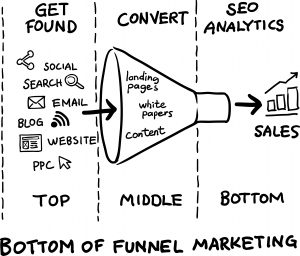I recently read an article on the differences between generations and how they purchase technology. It was an eye opener for me! As someone who has marketed technology and software solutions for many years, I am very interested in understanding what works at what stage in the buying process.
We often talk about the buyer journey; however, for B2B buyers it may not be as linear or as easy to measure as a consumer buyer journey. An in-depth understanding of how your B2B customers consume content helps companies to target and personalize content at the right time, to the right people — which is the “holy grail” for the marketer today.
The article states that these three groups Boomers, GenXers and Millennials search for, evaluate and ultimately decide upon technology solutions in very different ways. A sampling of the differences is below:
Top of Funnel
At the top of the funnel for a B2B technology purchase, each generation highlighted industry analysts as most influential at the earliest stage of the purchase process.
41% of Boomers rely on analysts, 31% of GenXers and 29% of Millennials
Middle of Funnel
Once in the evaluation process and the field narrowed to several vendors (generally considered middle of funnel), you will see a generational split.
- Boomers will evaluate vendors using vendor websites online communities/forums (36%), seek out live demos, web searches, and continue the path with industry analysts (34%).
- GenXers trust in-person meetings (33%), consume vendor website content (33%) and rely on analyst information.
- Millennials will turn to their peers and colleagues to help evaluate vendors (26%) and while still important, vendor website content is relied upon less than GenX or Boomers at an average rate of only 21%.
Bottom of Funnel
Once the three generations get to the bottom of the funnel, there is more agreement in how they create the short list. Tech buyers all use information from meetings and demos the most to help them make their final decision with a few interesting notes:
- Boomers weight live or in-person demos at 39%, Vendor Website at 35% and face to face meetings at 38%
- GenXers weigh case studies or testimonials and vendor face to face meetings at 27% and internal colleagues at 26%
- Millennials state vendor face to face meetings at 24%, internal colleagues at 23% and live or in-person demos are 21% influential to the buy cycle.
Where does this leave the B2B marketer on content strategy?
Content marketing is a strategy that the most successful marketers employ, and if done correctly (think high quality and relevant content), it crosses traditional and digital marketing channels. After all, you need to not only pull prospects into the sales funnel but also through the sales funnel.
One of the biggest challenges I have seen in organizations is a singular focus on one area of the content mix and not on the bigger picture. All of the pieces and parts of your marketing lead gen engine, such as social media marketing, PPC, SEO, public relations, inbound marketing efforts, in-person events, and loyalty programs, need to be working together in concert. And, based on the research above, different kinds of content need to be generated and available to prospects and customers to nurture them through the marketing and sales funnel.
For example, if you create a heavy-hitting white paper, then you should think about how to promote that content with infographics, video, online demos, and then align those pieces to your distribution channels– and the type of buyer: Boomers, GenXers and Millennials!
Three Tips to Improve Your Content Marketing Efforts
Understand Hidden Buy Cycle
Many buyers spend on average two-thirds of their time getting to know you online and through your blogs, white papers, webinars and other gated and ungated content before even contacting you. One way to work though whether your content is on the right path for tech buyers is to create a robust mix of content that can be consumed by your tech buyers as they go through the hidden buy cycle.
Analyze Your Content
It’s often a good idea to analyze content by establishing a post-mortem on your recent wins. This can help you understand what content was read and engaged with and for how long. Then you can begin to map out what your content goals are for future pieces. (i.e, Brand awareness, Lead Nurturing, conversion rate Customer Service & Support marketing, Retention & Loyalty rewards marketing, Upselling/cross selling)
Knowing what works and what doesn’t across your wins can help you replicate successful content marketing plans and distribution options.
Engage Your Sales Team
The sales team will often not fully understand or engage with the materials that marketing creates. I have found that working with the sales team to understand the questions that the buyers are asking throughout the sales cycle helps marketing understand the challenges and can address those issues in the content marketing plan. Of course, you will also need to educate sales and pre-sales support teams on how to use content and ensure that they understand the intent and are maximizing the use of your content, but that topic is a different nut to crack!
